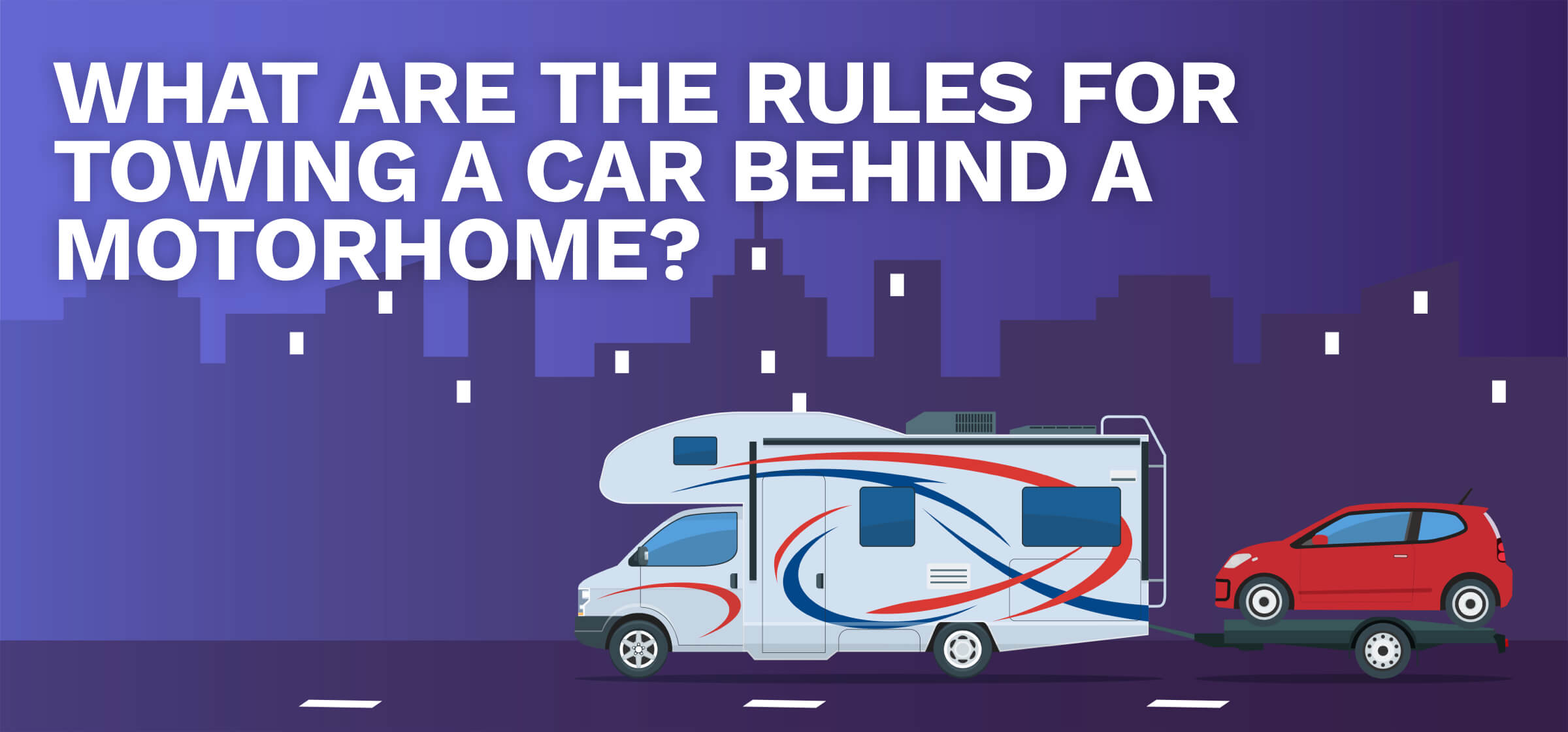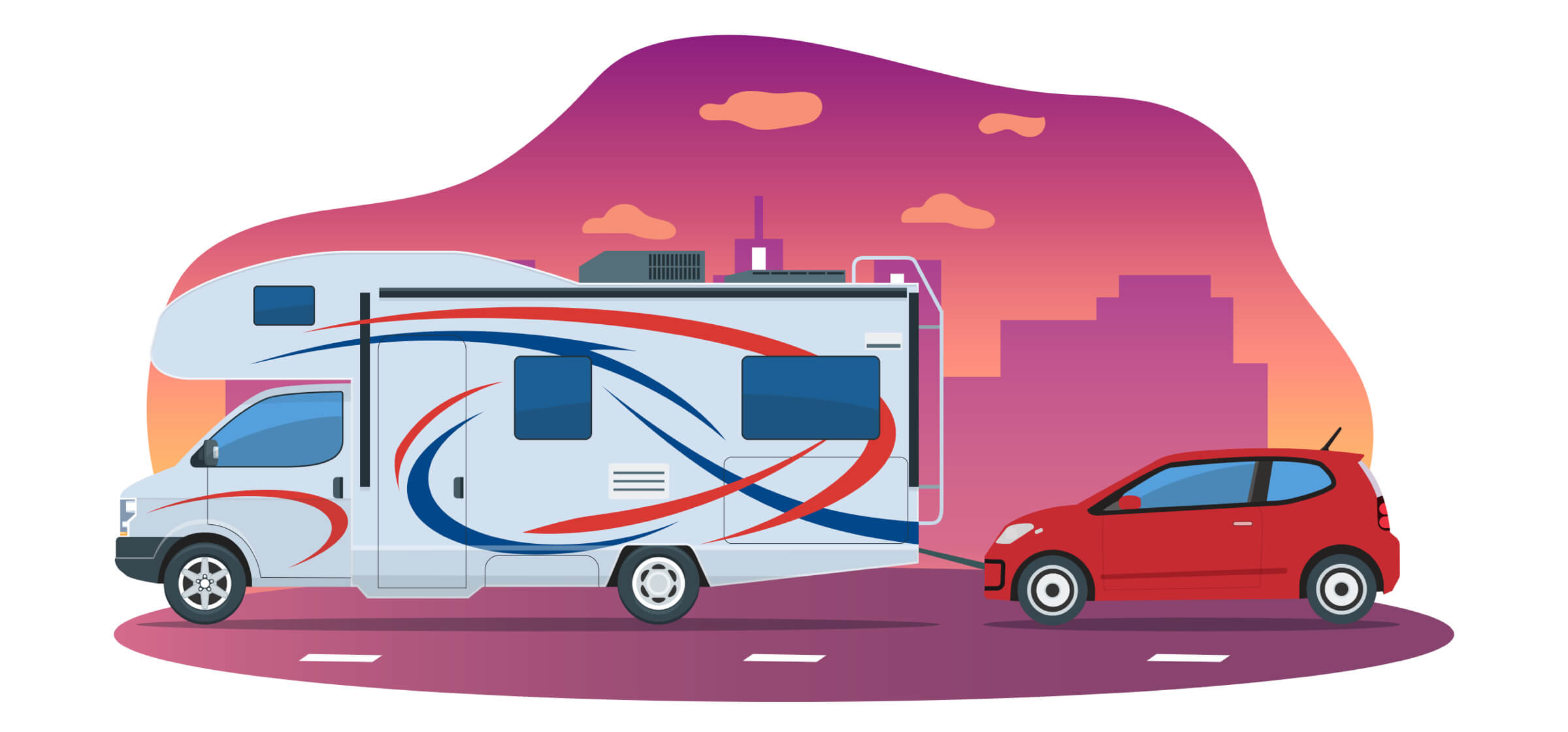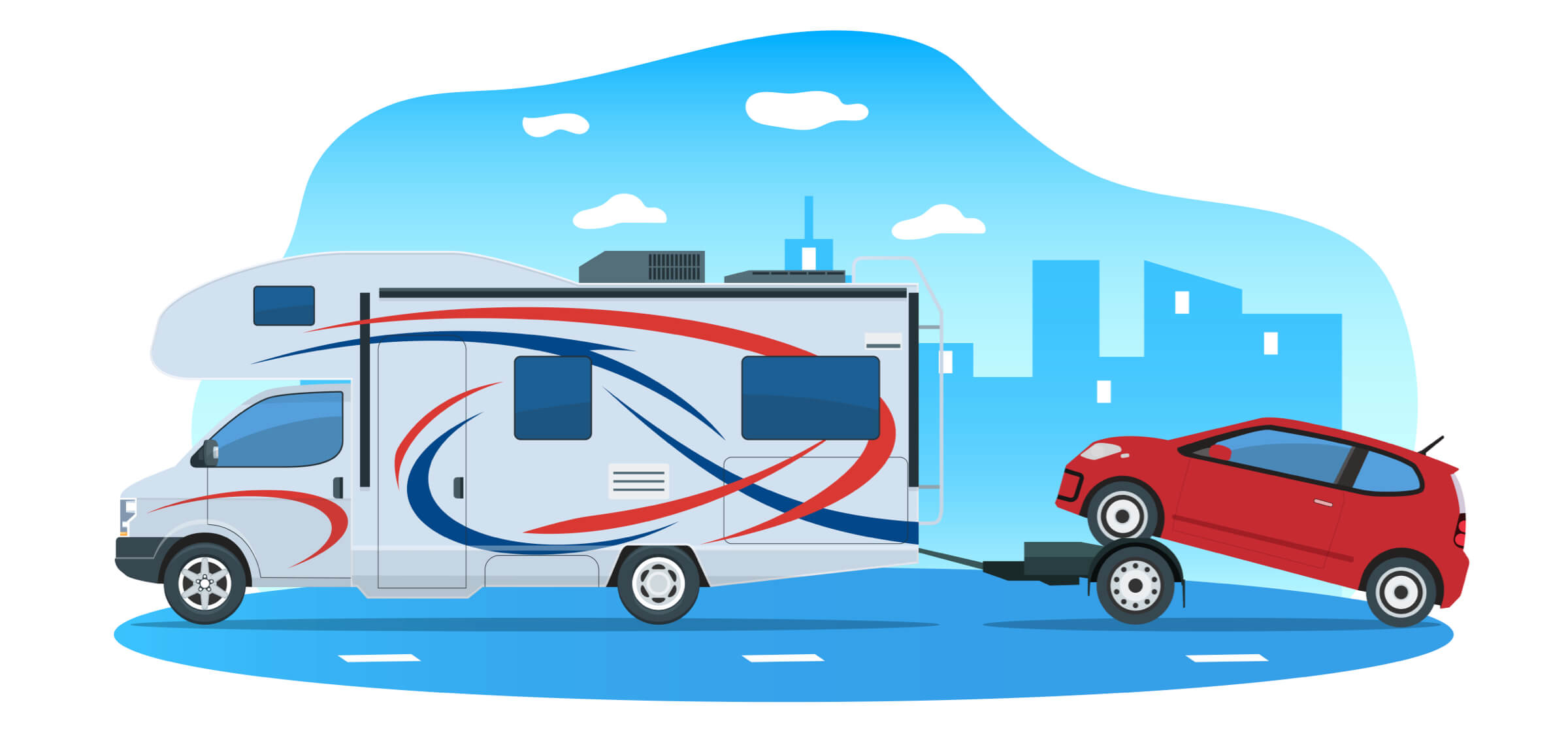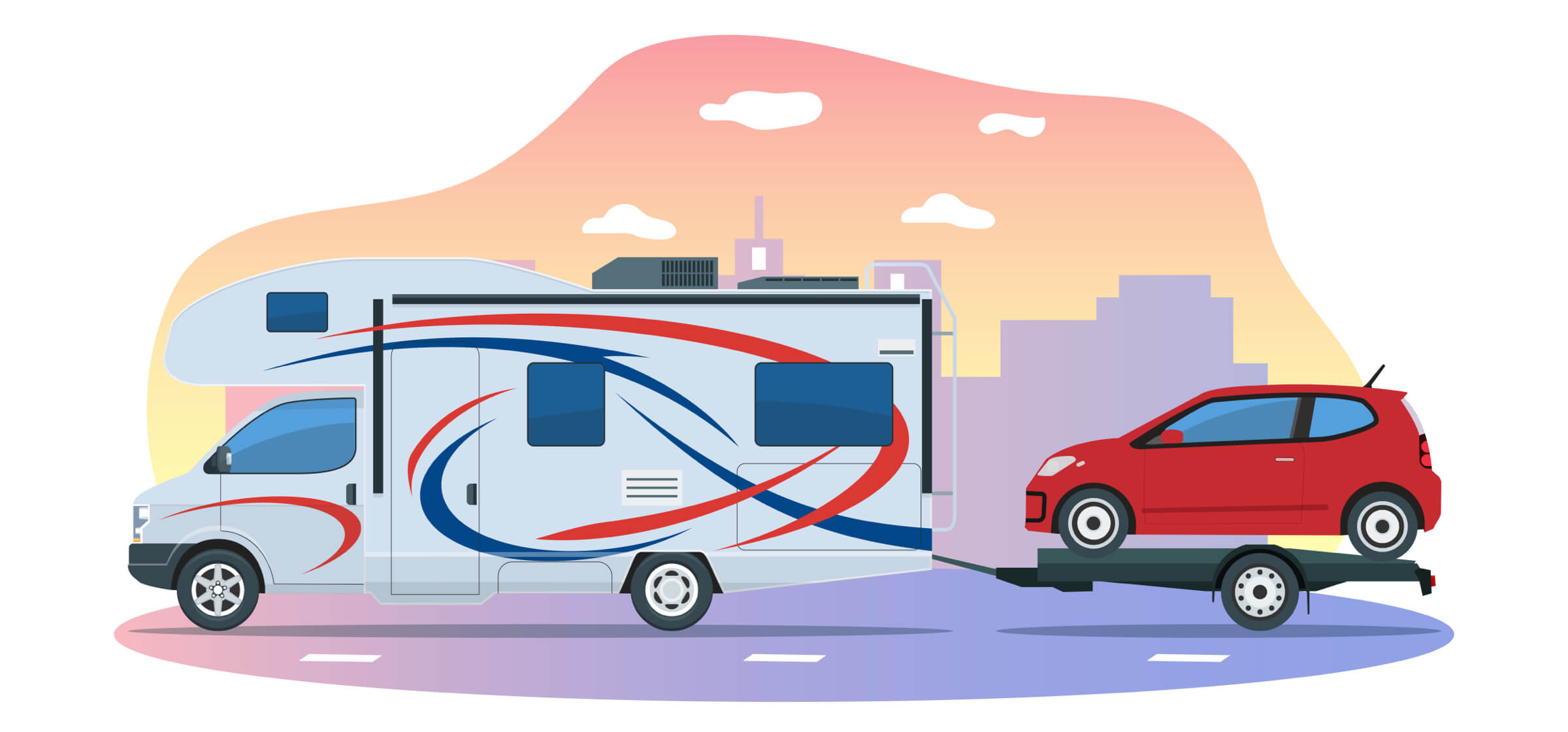
What are the rules for towing a car behind a motorhome?
If you're considering towing a car, boat or trailer behind your motorhome, but you're not sure what the rules are, you're in the right place. From towbars and how to tow to insurance and licensing laws, we've covered everything you need to know about towing a car behind a motorhome.
In this blog we'll answer the following questions:
- Why would you tow a car with a motorhome?
- What can your motorhome tow? And how can you tow it?
- What are the rules around braked and unbraked trailers or vehicles?
- Do you need special insurance?
- What towbars can be used on a motorhome?
- What are the current licensing rules?
- Can you tow a car with a motorhome internationally?
- How to safely tow a car behind a motorhome: A summary
Why would you tow a car with a motorhome?
We can think of plenty of reasons why you may want to use your motorhome as a towing vehicle - that's why there are so many towing accessories available!
Towing with your motorhome can give you the extra flexibility you need to make your holiday more enjoyable. For example:
- A motorhome isn't nifty when driving through towns or cities or even winding country roads. Towing a smaller car avoids the hassle of packing up and moving the motorhome constantly and makes day trips and adventures that little bit easier.
- Motorhomes can be difficult to park, particularly in built-up cities or busy tourist attractions. The flexibility of having a smaller car removes the stress of manoeuvring a bulky motorhome, making sightseeing more accessible.
- Travelling as a group? If the motorhome is full of people or luggage, towing a car provides extra space for passengers or bulky items like bikes, kayaks, or even another small camper trailer.
- Towing a car can offer peace of mind in case your motorhome breaks down. You'll have a backup vehicle to reach help or temporary accommodations.
What can your motorhome tow? And how can you tow it?
Towing a car isn't as complicated as you might think but there are a few legal requirements you need to know and consider - and the towing limit of your vehicle is an important one.
What you can tow depends on the maximum towing limit of your vehicle, this can be confirmed by your vehicle's manufacturer. Alternatively, you can work out how much your vehicle can tow by following our guide to working out your towing capacity.
Length and width of the towed car
As well as towing capacity, you will also be restricted to a towing width and length. The maximum width your towing vehicle can tow is 2.55 metres. The maximum trailer length towed by a vehicle weighing up to 3,500kg is 7 metres and doesn't include the A-frame.
The best towing vehicles are usually rear-wheel drive, which is what your motorhome is likely to be.
Choosing a towing method
To tow your vehicle behind a motorhome there are a few different options, including the following:
- A-Frames
- Two-wheeled dollies
- Trailers
Towing A-Frames
A towing A-frame is also referred to as a trailer. An 'A' shaped metal frame that attaches to the front of a vehicle and enables flat towing. A-frames can be used for a variety of different things, including the transportation of other vehicles and large loads. As long as the trailer, or A-Frame, does not go over the towing capacity of the vehicle, you can use it for just about anything.
Pros
- Compact and lightweight
- An affordable option that requires little maintenance
Cons
- Braking and lighting requirements need to be met and may need additional towing electrics
- Reliably reversing with an A-frame attachment can be challenging because of the pivot at the front
- An A-frame isn't suitable for towing bigger cars
- Using an A-frame is illegal in many EU countries

Two-wheeled Towing Dollies
When you use a two-wheeled towing dolly to tow a car, one set of the car's tires, front or rear, is on the ground, while the other end is suspended on the dolly. When using this type of dolly, it is important to know that your motorhome has an adequate braking system, and that the combined weight of the dolly and the vehicle being towed does not exceed the amount the towing vehicle can pull.
Pros
- Compact and lightweight
- An affordable option that requires little maintenance
- Easy to manoeuvre
Cons
- Backing up with a tow dolly can damage the hitching system, the dolly itself, or the car that's being towed.
- Increased wear of the front or back wheels depending on which ones are in contact with the ground
- It can be tricky to load cars onto a tow dolly and takes a bit of practice

Trailers
If you own an automatic car or a permanent 4x4 it cannot be towed behind a motorhome unless all 4 wheels are off the ground and thereby on a trailer.
Pros
- Trailers come in a range of sizes and weight capacities
- Easier to use for reversing than an A-frame
Cons
- More expensive than other options but they tend to hold their value
- Storage space could be an issue when not in use

What are the rules around braked and unbraked trailers or vehicles?
If you are towing a car weighing less than 750kg, the braking system must still operate correctly and effectively. This applies to all cars and trailers that are being towed and have their own braking system. However, trailers that have a maximum laden weight which does not exceed 750kg do not legally require their own braking system.
What considerations do you have to make about electrics?
Just like a trailer or bike rack needs to have sufficient towbar electrics for you to legally tow, the same rules apply if you are towing a car or A-frame. The car or A-frame you are towing should be connected to the towing vehicle's electrics via towbar wiring. This means that all the lights and signals will still be visible to other road users. Not only that, but the registration number plate of the towing vehicle must be clearly displayed on the back of the A-frame or the vehicle that is being towed.
Do you need special towing insurance?
You don't necessarily need special insurance to tow your car with a motorhome, you just need to have the correct coverage for the car and motorhome already in place. Consider what cover is provided by your policies, as your motorhome insurance policy should provide third party insurance for a towed car whilst it is attached to the motorhome. Any damage that occurs to the car itself whilst being towed should be covered by the car policy, if you have comprehensive cover.
If you are planning on taking your motorhome abroad and towing a car, you need to make sure that the car insurance provides foreign use, and is covered for the length of time you plan to be abroad. Watch out for added premiums, as some private car insurance policies only provide a limited number of days per trip. We recommend you arrange for anything longer than this to be added to your policy.
We would also recommend that before you head off on your adventure, to check with your insurance company that you're fine to do so, and covered on all bases. Just in case!
What towbars can be used on a motorhome?
At Witter we sell a range of towbars that are suitable for use on motorhomes. Our range of towbars consists of:
Fixed Flange: The towball is bolted onto a faceplate and is permanently attached to your vehicle. This is ideal for serious towing, compatible with accessories and usually the cheapest option.
Detachable Flange: Robust and versatile like the fixed flange, the detachable flange comes with the added benefit of being able to remove the towbar when you are not using it.
Fixed Swan Neck: With a sleeker design, the fixed swan neck is more pleasing to the eye. It is compatible with AL-KO stabilisers, however, you cannot tow and carry bikes at the same time.
Detachable Swan Neck: With the same visual appeal as the fixed swan neck, you are also able to remove this when you are not towing. But, you can't tow and carry bikes at the same time.
Retractable Towbar: When not in use, it can be folded away out of sight in a matter of seconds. Offering the same advantages as a detachable towbar.
Check out our range of towbars today and see what works for your motorhome.
What are the current driving licensing rules for towing?
In 2021, the government issued new rules for towing in the UK.
As a basic requirement a full car driving licence (Category B) is mandatory for all towing in the UK. This licence allows you to drive a car with a maximum authorised mass (MAM) of 3,500kg and tow a trailer up to 750kg, but the combined MAM of the car and trailer cannot exceed 3,500kg.
Rules for towing trailers up to 3,500kg MAM:
- No additional tests are required, regardless of when you passed your driving test. This change applied from 16 December 2021.
- The combined MAM of the car and trailer must not exceed 3,500kg. This means the trailer can be heavier than the towing vehicle, as long as the total weight stays within the limit.
- There are no separate weight limits for the car and trailer. As long as the combined MAM remains under 3,500kg, you are within the legal boundaries.
- Check the MAM of both your car and any trailer you want to tow. Exceeding the limits can lead to fines and potentially invalidate your insurance.
Rules for towing heavier combinations (over 3,500kg MAM):
Additional tests are required depending on the weight and category of the trailer/vehicle combination.
- BE test: This test is required for towing trailers exceeding 3,500kg MAM but with a total MAM under 12,000kg. This category covers heavier caravans, boat trailers, and small horseboxes.
- C1+E test: This test is required for towing heavier trailers/vehicles with a combined MAM exceeding 12,000kg. This category covers large caravans, horseboxes, and goods trailers.
Additional guidance if you passed your driving test before 1997…
- Individuals who passed their driving test before 1 January 1997 have a 'grandfather clause'. This grants them the continued right to tow a vehicle and trailer combination up to 8,250kg without needing any additional tests. This is referred to as the C1 entitlement.
- However, this entitlement may be revoked after the age of 70. To continue towing beyond this age, you will need to have a doctor's certificate confirming your fitness to drive.
Can you tow a car with a motorhome internationally?
The most important thing you can do before towing internationally is to check the towing laws for the country you wish to tow in. While you can tow a car with a motorhome, using an A-frame, in the UK this is not necessarily the case in Europe and further afield.
Can you use a towing A-frame in Europe?
You can use an A-frame in the UK, however they're not always compatible with modern vehicles and their advanced safety features. Advanced features like emergency braking, regenerative braking, and electronic stability control can actually mean that modern vehicles don't meet legal requirements for towing an A-frame. So, while you can use them in the UK, you need to be sure you can legally tow an A-frame with your vehicle.
While an A-frame is fine to use in the UK, in line with the above guidance, it is not recommended to use one in the rest of Europe. That is because other European countries do not share the same views on A-frames as we do in the UK. So, it is recommended that you carry out thorough research into the country you are visiting before travelling to make sure you are abiding by the laws of that country.
How to safely tow a car behind a motorhome: A summary
Towing a car behind a motorhome can be a convenient way to explore with an extra vehicle, but here are the key rules you need to know to do this safely:
Weight and Capacity
- Overall weight: Ensure your motorhome's towing capacity can handle the combined weight of the towed car and any additional cargo. Exceeding the capacity can be dangerous and illegal.
- Brakes: If the towed car weighs more than 750kg, it must have functioning electric or hydraulic brakes that operate in sync with the motorhome's brakes, this can be achieved with electric keys and/or a trailer board.
Equipment and Visibility:
- Towbar: Use a properly installed and maintained towbar designed for your motorhome and the towed car's weight.
- Trailer lights and indicators: Ensure the towed car's lights and indicators are operational and connected to the motorhome through a compatible towing electric system.
- Towing mirrors: If the towed car obscures your rearview vision, you must use properly adjusted towing mirrors to maintain visibility.
Speed and Driving Tips:
- Speed limits: Be aware of reduced speed limits for towing, typically 50 mph on single carriageways and 60 mph on dual carriageways and motorways in the UK.
- Manoeuvring: Allow for wider turns and increased stopping distances when towing. Practice reversing with the car on a trailer before venturing on the road.
- Roadworthiness: Both the motorhome and towed car must be roadworthy with valid MOTs and insurance.
Additional Regulations:
- Licence requirements: In the UK, if you passed your driving test before 1997, you can tow up to 8,250kg without an additional test. If you passed after that, you might need a BE test depending on the combined weight. Check the latest rules for your country.
- Trailer signage: Display the towed car's number plate at the rear, not the motorhome's.
General Safety Tips:
- Pre-trip checks: Before setting off, thoroughly check tire pressures, brakes, lights, and all connections for both the motorhome and towed car.
- Securely load the towed car: Distribute weight evenly and properly secure the car to the trailer or dolly to prevent shifting during travel.
- Take breaks: Plan frequent breaks to stay alert and avoid driver fatigue.
- Maintain awareness: Be mindful of other road users and allow extra space for manoeuvring, especially on narrower roads.
The world of towing cars behind motorhomes can be a little confusing, with all the consideration of weights and insurance. But once you've got that all sorted, it'll be well worth it. So, if you're all ready to hit the road, enjoy the journey. A motorhome holiday can take you to places that some normal holidays can't - the motorhome life is waiting for you! As long as you're all clued up on the rules and regulations, and you're prepared for your journey, we're sure you'll have a great time.

